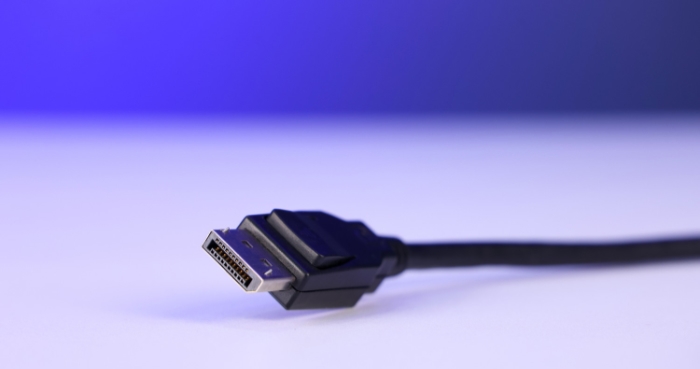DisplayPort 1.2 vs. 1.4: What to Pick?

Technology enthusiasts and professionals alike recognize the importance of staying updated with the latest developments in digital display interfaces. Among these, DisplayPort stands out as a key player, having undergone significant evolution since its inception.
This evolution has brought about various versions, each offering distinct features and capabilities. Understanding the differences between these versions is not just about technical specifications; it’s about appreciating the strides made in enhancing our visual and audio experiences.
Technical Specifications of DisplayPort 1.2
DisplayPort 1.2 marked a significant advancement in display technology when it was introduced. It set new standards for audio and video transmission, making it a popular choice for a wide range of applications, from gaming to professional environments.
Maximum Bandwidth and Data Rate
DisplayPort 1.2 introduced a notable increase in bandwidth compared to its predecessors. With a maximum bandwidth of 21.6 Gbps, it significantly enhanced the capacity for data transmission.
This increase in bandwidth allowed for higher resolution displays and more efficient data handling, making it suitable for demanding applications.
Resolution and Refresh Rate Capabilities
One of the standout features of DisplayPort 1.2 is its ability to support high resolutions and refresh rates. It can handle up to 4K resolution at 60 Hz, making it an excellent choice for high-definition video content.
This capability is particularly important for applications requiring detailed visual outputs, such as graphic design and gaming.
Audio and Color Support
DisplayPort 1.2 doesn’t just excel in video; it also supports high-definition audio transmission. This makes it an all-in-one solution for both video and audio, simplifying the connectivity requirements for users.
Additionally, it supports a wide color gamut, ensuring accurate and vibrant color reproduction, essential for professional video and photo editing tasks.
Compatibility with Other Standards and Devices
Compatibility is a critical aspect of any technology, and DisplayPort 1.2 excels in this area. It is backward compatible with previous versions of DisplayPort, allowing users to integrate it seamlessly into existing setups.
Furthermore, it supports various adapters and converters, enabling connections with different types of displays and devices, enhancing its versatility in various use cases.
DisplayPort 1.2 set a new benchmark in the realm of digital display interfaces with these technical specifications, laying the groundwork for future advancements in display technology. Its combination of high bandwidth, resolution support, and compatibility made it a versatile and powerful option for a broad range of applications.
Advancements in DisplayPort 1.4
DisplayPort 1.4 represents a leap forward in display interface technology, building upon the foundations laid by its predecessor, DisplayPort 1.2. This newer version brought with it a host of enhancements, from improved bandwidth management to support for emerging display technologies.
These advancements have made DisplayPort 1.4 a preferred choice for high-end displays and multimedia applications.
Enhanced Bandwidth and Data Rate
Although DisplayPort 1.4 maintained the same maximum bandwidth as 1.2, at 21.6 Gbps, it introduced more efficient bandwidth utilization. This efficiency was achieved through the implementation of Display Stream Compression (DSC), a major feature in this version.
DSC allows for higher resolution displays without requiring additional bandwidth, making the most of the available data rate.
Improvements in Resolution and Refresh Rates
DisplayPort 1.4 further expanded the capabilities in terms of resolution and refresh rates. It supports 8K resolution at 60 Hz and 4K at 120 Hz, a significant jump from the 4K at 60 Hz limit of DisplayPort 1.2.
This advancement is particularly beneficial for applications where visual fidelity and fluid motion are paramount, such as in advanced gaming setups and professional video editing.
Introduction of Display Stream Compression (DSC)
DSC, introduced in DisplayPort 1.4, is a form of visually lossless compression. It allows for the transmission of higher resolutions without compromising the image quality, effectively managing the available bandwidth.
This technology has been crucial in enabling support for ultra-high resolutions and HDR content within the existing bandwidth limits.
Support for HDR and Deeper Color Ranges
High Dynamic Range (HDR) support is another significant enhancement in DisplayPort 1.4. HDR provides a richer and more dynamic range of colors, leading to more lifelike and vibrant images.
Alongside HDR, DisplayPort 1.4 also supports wider color gamuts, essential for professional-grade video production and photography work.
Compatibility Advancements with Newer Devices and Standards
DisplayPort 1.4 continued to support backward compatibility, ensuring seamless integration with existing DisplayPort devices and systems. Moreover, it aligned with the latest industry standards, ensuring that it stays relevant and functional with newly developed technologies and devices in the digital display realm.
These advancements make DisplayPort 1.4 a robust and future-proof choice for users seeking the highest quality in video and audio transmission. Its ability to support emerging technologies while maintaining compatibility with existing systems marks it as a key player in the ongoing evolution of digital display interfaces.
Performance Comparison

Evaluating the performance of DisplayPort 1.2 and 1.4 is crucial in understanding their respective roles and capabilities within the realm of digital display technology. This comparison not only highlights the technical advancements but also provides insight into how these differences translate into real-world applications.
Bandwidth Utilization
While both DisplayPort 1.2 and 1.4 offer the same maximum bandwidth of 21.6 Gbps, the way they utilize this bandwidth differs significantly. DisplayPort 1.4, with its introduction of Display Stream Compression (DSC), optimizes the use of available bandwidth, allowing for higher resolutions without the need for additional data capacity.
This efficient use of bandwidth is a major factor in its ability to support higher resolutions and refresh rates.
Resolution and Refresh Rate
Resolution and refresh rate are key factors in display performance, especially in high-end gaming and professional video applications. DisplayPort 1.2 supports up to 4K resolution at 60 Hz, which was impressive at its release.
However, DisplayPort 1.4 extends these capabilities, supporting 8K resolution at 60 Hz and 4K at 120 Hz, catering to the growing demand for ultra-high-definition content and smoother video playback.
Audio-Visual Experience
The introduction of HDR and enhanced color range support in DisplayPort 1.4 marks a significant improvement in the overall audio-visual experience. While DisplayPort 1.2 provides robust audio and color support, 1.4 takes it a step further with HDR, offering more vibrant and realistic imagery.
This is particularly beneficial for applications where visual fidelity is paramount.
Gaming and Professional Use
For gamers and professionals, the differences between these two versions are particularly noteworthy. DisplayPort 1.4’s support for higher refresh rates and resolutions translates to smoother and more immersive gaming experiences.
Similarly, professionals in video production and photography benefit from the enhanced color accuracy and high resolution that DisplayPort 1.4 offers.
Overall Suitability
In a general sense, DisplayPort 1.2 continues to be a reliable choice for standard applications, offering high-quality audio and video support. However, for users seeking cutting-edge performance, particularly in gaming, professional video, and photography, DisplayPort 1.4 presents a more future-proof solution with its advanced features.
User Considerations and Recommendations
Choosing between DisplayPort 1.2 and 1.4 involves more than just comparing technical specifications; it requires a thoughtful consideration of user-specific needs and future requirements. This section provides guidance on the factors users should consider when selecting between these two versions, ensuring their choice aligns with both current needs and future expectations.
Evaluating Current Equipment and Requirements
The first step in deciding between DisplayPort 1.2 and 1.4 is assessing current equipment and usage requirements. Users with existing hardware that supports DisplayPort 1.2 and does not require high-end capabilities may find this version adequate.
It is essential to evaluate the compatibility of current devices with these DisplayPort versions to ensure seamless integration.
Future-Proofing and Technological Advancements
For users looking to future-proof their setup, considering technological advancements is crucial. DisplayPort 1.4, with its support for higher resolutions, HDR, and DSC, is better suited for upcoming trends in digital displays.
This version is recommended for those who plan to upgrade their systems or expect to engage with more advanced display technologies in the future.
Cost Implications
Cost is a significant factor in the decision-making process. DisplayPort 1.4 devices and cables may come at a premium compared to 1.2.
Users must balance the benefits of the advanced features of 1.4 against the additional cost, especially if their current needs do not demand such high specifications.
Specific Needs of Different User Groups
Different user groups have varying needs when it comes to display technology. Gamers and professionals in video production or graphic design typically require higher resolutions and refresh rates, making DisplayPort 1.4 a more suitable choice. In contrast, general users and those with standard display requirements may find DisplayPort 1.2 sufficient and more cost-effective.
Recommendations for Various Scenarios
- For users primarily involved in standard office work or casual entertainment, DisplayPort 1.2 is a practical and cost-effective choice.
- Gamers and professionals in fields requiring high-definition visuals should consider DisplayPort 1.4 for its advanced capabilities.
- Those planning to upgrade their display systems in the near future might opt for DisplayPort 1.4 to ensure compatibility with newer technologies.
Conclusion
DisplayPort technology, through its iterations of 1.2 and 1.4, showcases a remarkable journey of advancement in digital display interfaces. DisplayPort 1.2, with its robust capabilities, set a high standard in audio and video transmission, catering to a wide range of applications.
However, DisplayPort 1.4 takes these accomplishments further, introducing enhanced features like higher resolutions, refresh rates, and HDR support, making it a preferred choice for cutting-edge applications and future-proofing needs.
Key considerations for users range from current equipment compatibility and specific use-case requirements to budget constraints and future technological trends. While DisplayPort 1.2 remains a viable option for standard applications, DisplayPort 1.4 emerges as the go-to for those seeking advanced capabilities and aiming to stay ahead in the rapidly evolving digital display landscape.
Ultimately, the decision between DisplayPort 1.2 and 1.4 hinges on individual requirements and expectations. Users must weigh the benefits of each version against their specific needs, ensuring their choice aligns with both their current and anticipated future requirements.
By doing so, they can harness the full potential of DisplayPort technology, enhancing their digital experience in both personal and professional realms.



